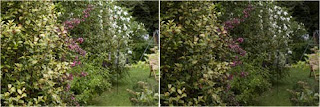Off Camera Flash Portrait
This is a very simple set-up using one off camera Speedlite or hot shoe flash to create a stunning portrait.
This portrait was created on in my back yard under a large sun shade which was actually protecting us from rain. First of all I needed to evaluate my background exposure and then set the camera so that the background didn't overpower the foreground.
Initial Exposure1/100th sec f4 100 ISO and Background exposure 1/200th sec f4 100 ISO
I set the camera to 100 ISO and daylight colour balance. I then shot a frame to judge the background exposure, left above and decided I'd like it darker so under exposed by 1 stop. The initial frame was shot with the camera set to Av (Aperture value) the second with M (Manual). Initial exposure f4, 1/100th sec, actual exposure f4 1/200th sec.Background exposure 1/200th sec f4 100 ISO with subject in place
The light source is to camera left, approximately 2 feet from the subject. In this case the light source is a Canon 550 EX Speedlite fitted with a scoop reflector pointing onto a flat white disc reflector to give a broad even light. The Speedlite is clamped to the umbrella upright with a Manfrotto 175 Justin clamp and the disc reflector held in place with a Joby Gorillapod SLR. The Speedlite was set to Manual 1/8th power and trigger with a cheap Ebay radio trigger. Had I pointed the Speedlite through the white disc I probably could have set the power to 1/16th or even 1/32nd. The white disc is translucent so light was being lost through the disc behind the photographer.
Remember that the closer your light source is to your subject the softer it will be and will also fall off quicker. You should aim to keep your power settings as low as possible so the flash recycles quickly and you don't miss fleeting expressions.
Canon 55 EX Speedlite with White Scoop Fired onto White Disc Reflector
The "straight" frame without any warming on the flash and an under exposed background
The "warm" frame with a Roscolux #08 on the flash and an over exposed background
Personally, I prefer the warmer frame. When you're shooting a portrait it's worth experimenting with warming gels on the flash and varying the background exposure. In this case I could achieve a brighter background as the subject was positioned under a dark green sun shade which flagged or shaded the ambient light. The green colour did not effect the overall colour of the image as the sky was heavy cloud and no light was reflected from the umbrella onto the subject.
I know photographers who keep either a Roscolux #08 Pale Gold or even a Roscolux #3409 RoscoSun 1/4 CTO (Colour Temperature Orange) on their flash permanently for photographing people, especially in England - saves the expense of a foreign holiday or sun bed sessions!
QUICK TIP
If you can do it in camera, it's generally quicker than in post-production! I know where I prefer to be, and that's not sitting in front of a screen.
QUICK TIP
If you can do it in camera, it's generally quicker than in post-production! I know where I prefer to be, and that's not sitting in front of a screen.







Comments
Post a Comment